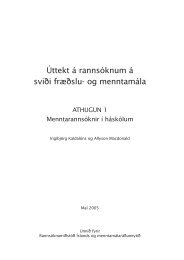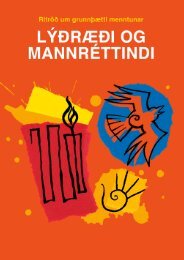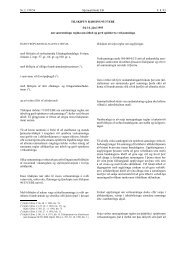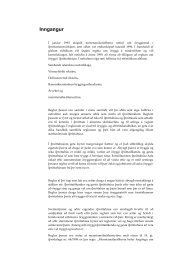Nomination of
Nomination of
Nomination of
You also want an ePaper? Increase the reach of your titles
YUMPU automatically turns print PDFs into web optimized ePapers that Google loves.
SURTSEY – NOMINATION FOR THE UNESCO WORLD HERITAGE LIST<br />
Fig. 2.6. Geological map <strong>of</strong> Surtsey. Topography is based on aerial photographs from August 2004. See also enclosed<br />
map in the scale <strong>of</strong> 1:5000.<br />
Surtsey has a surface area <strong>of</strong> 1.41km 2 , a maximum<br />
width from west to east <strong>of</strong> 1.33 km and a<br />
maximum length from north to south <strong>of</strong> 1.80 km<br />
(Fig. 2.6; see also enclosed map). It is the second<br />
largest island <strong>of</strong> the Vestmannaeyjar group, followed<br />
by Elliðaey (0.46 km 2 ) and Bjarnarey (0.33<br />
km 2 ). Although the highest elevation on Surtsey is<br />
only 155 m, the sea depth prior to the eruption<br />
was about 130 m, so that the true height <strong>of</strong> the<br />
volcano is 285 m.<br />
Surtsey's prominent topographical features are<br />
two crescent-shaped cones composed <strong>of</strong> tephra<br />
and palagonite tuff, along with a lava field that<br />
caps the southern half <strong>of</strong> the island. Rising to an<br />
elevation <strong>of</strong> 155 m, the eastern cone,<br />
Austurbunki, is marked by several small lava<br />
16<br />
craters and fissures. The western cone, Vesturbunki,<br />
whose height is 141 m, has large slump<br />
scars due to marine abrasion on its western side,<br />
where a 135-m-high sea cliff has formed. From<br />
the tuff cones, the main lava field forms a shield<br />
gently dipping to the south and east. Transported<br />
coastal sediments have mainly been deposited at<br />
the north end <strong>of</strong> the island, constructing a broad<br />
spit.<br />
The shape <strong>of</strong> Surtsey is constantly modified by<br />
the harsh weather conditions which prevail in the<br />
sea south <strong>of</strong> Iceland, particularly during winter.<br />
Heavy sea waves erode the coast and produce<br />
coastal sediments. Being easily eroded and<br />
transported by the wind, loose, unconsolidated<br />
tephra has collected as aeolian deposits along the







![Aðalnámskrá tónlistarskóla : rytmÃsk tónlist [Eingöngu á rafrænu formi]](https://img.yumpu.com/50843672/1/184x260/aaalnamskra-tanlistarskala-rytma-sk-tanlist-eingangu-a-rafranu-formi.jpg?quality=85)









